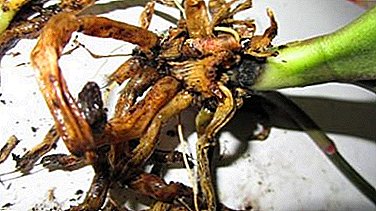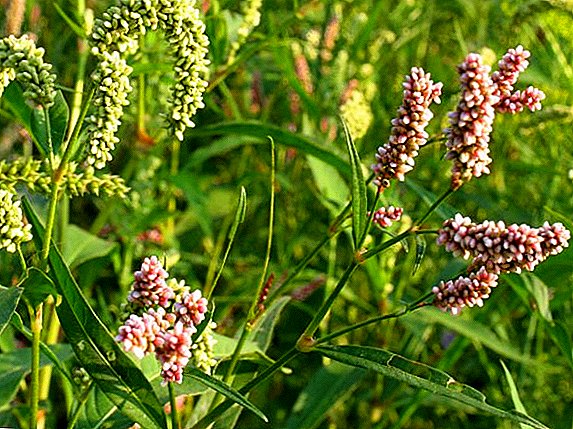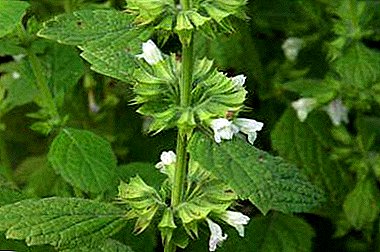
Sometimes it happens that an orchid gets sick. Most often this is due to poor conditions, improper handling and various parasites. Experienced growers recommend to inspect immediately at the time of purchase. Most of the symptoms can be identified visually. The main causes of core rot are pathogenic bacteria and fungi.
External manifestations
Rot is a disease caused by phytopathogenic fungi and bacteria. In the process of development, decay leads to the defeat of leaf blades, stem, roots, at a more advanced stage - to the complete rotting, drying out and early death of decorative flowers. Externally, it appears as dark spots near the base of the exotic. Over time, they tend to grow. Entails the yellowing and darkening of the leaves, and their further fall off.
The condition of the orchid in this disease:
- Weakness.
- Poor decorative quality.
- The duration of flowering is reduced.
- Growth stops.
- The turgor is lost.
What are the consequences?
 Since the flower has one growth point, you need to ensure that it does not rot. Indeed, after its death, development will cease, and the plant will subsequently die. Also, if the heart has rotted, the orchid loses its foliage. It becomes soft, loses elasticity, and then completely falls off. Next comes the root damage.
Since the flower has one growth point, you need to ensure that it does not rot. Indeed, after its death, development will cease, and the plant will subsequently die. Also, if the heart has rotted, the orchid loses its foliage. It becomes soft, loses elasticity, and then completely falls off. Next comes the root damage.
With a high humidity in the room, infected areas of the flower overgrow with spores of rot, and this is fraught with throwing the disease on other pets. Therefore, it is very important to know what to do if the orchid is rotting and to take urgent measures to eliminate the ailment. Only timely help will give orchids a second chance for life. In the later stages will not save anything.
What is the cause of damage to the trunk?
- Mechanical damage.
Rot can be formed as a result of the fall or injury of a part of the flower. If time does not provide assistance, that is, to treat the damaged area with an antiseptic, the result will be rotting of the stem.
- Frostbite.
Novice flower growers carelessly produce watering. They make a warm shower for the orchid, but at the same time they forget about the water that accumulates in the sinuses. In the summer, there is nothing dangerous about it. Due to the hot weather, the water will evaporate quickly.
Important! But in the winter, the flower is threatened with frostbite, especially standing on a stone window sill. The fluid will not evaporate, but will remain in the sinuses for a long time.
- Fungal and bacterial infections. In case of violation of the indoor microclimate, infectious diseases occur. It is also possible if the quarantine was not respected. As soon as an infection was detected, the flower must be immediately isolated from the rest of the plants so that the ailment does not spread to them.
How to determine that the plant has a rotten stem?
- The foliage becomes less elastic, has a not so bright color, loses a tone.
- At the base of the sheet you can see a brown tint.
- Green mass quickly dies.
- Dark spots on the trunk and neck.
- Green traces of sporulation are visible on the walls of the pot.
- The upper part of the flower is loose and unstable.
The better to handle?
Chemicals
 One of the most effective drugs are fungicides. These funds are intended for the elimination of pathogens of fungal diseases in plants. The composition of fungicides may include the following components: mercury, manganese, organic substances, copper, aldehydes.
One of the most effective drugs are fungicides. These funds are intended for the elimination of pathogens of fungal diseases in plants. The composition of fungicides may include the following components: mercury, manganese, organic substances, copper, aldehydes.
The most famous drugs:
- Fitosparin-M actively destroys fungus and bacteria.
- Quadrix - has a wide spectrum of action, azoxystrobin is taken as a basis. It is used for prophylactic and therapeutic purposes.
- Copper sulfate - made on the basis of copper sulfate, the result is visible after only 3-4 hours.
- Bordeaux mixture - prepared on the basis of copper, and also includes lime, which lowers the acidity of the soil.
- Mikosan - well helps in the initial stage of the disease, stimulates the immune system.
Folk methods
With small areas of damage at the initial stage of the disease, it is possible to use folk remedies:
- Iodine solution. 5-7 drops of a substance are diluted with 5 liters of water and a flower is sprayed once a week.
- Mustard Infusion. It will take 5 liters of hot liquid, in which you need to dilute 50 grams of mustard powder. Then the solution should be infused for at least 2 days. Before you apply, diluted 1: 1 with water.
- Garlic tincture. During the day, you need to insist 100 grams of husk in 10 liters of water.
Although natural products are harmless and easy to prepare, they can only help at the onset of the disease.
Step-by-step instructions for decay
Necks
- The first step is to prepare the blade and sanitize it.
- Further, the entire damaged part of the neck is trimmed down to the living tissue.
- Carefully clean the blade with cuts.
- Then the soil and orchid are treated with 0.2% solution of Fundazole. Means poured directly on the wound.
- This is done 3-4 times with an interval of 2 weeks.
- The pot is put in the previous place, waiting for the appearance of the side kids.
To deal with the rotted neck of an orchid, watch the video:
At the growth point
- Remove all infected places so that not a single dark spot remains.
- Slices are sanitized.
- If the disease is infectious or as a precaution, local-acting fungicides are used.
- Orchid will need constant inspection, because the rot can return.
If the rot hit the growth point, watch this video:
Cores
- Rotten places are removed.
- If necessary, the core is removed completely.
- After each cut, the tools are processed.
- Wounds are cauterized by cinnamon, iodine, activated carbon.
- Carefully observe the state of the plant.
Prevention
- Maintaining optimum temperature is an integral part of care. In the summer, it should be + 23 ... +25 degrees, and in the winter to be within + 15 ... +18. Swings no more than 5 degrees.
 Humidity 50-50%.
Humidity 50-50%.- In the first week after the procedure does not need watering. Then you need to let the ground dry out and not water more often 1 time in 10 days.
- Stagnant water must be removed from the sinuses.
- The use of mineral preparations is excluded.
- The lighting is not bright and diffused.
- The room with an orchid periodically air.
All lovers of orchids is important to remember: only in weakened plants can the neck and other organs rot. When an exotic flower has good immunity, he is not afraid of anything. Follow the basic rules of care, then you will not have to take emergency measures.


 Humidity 50-50%.
Humidity 50-50%.









